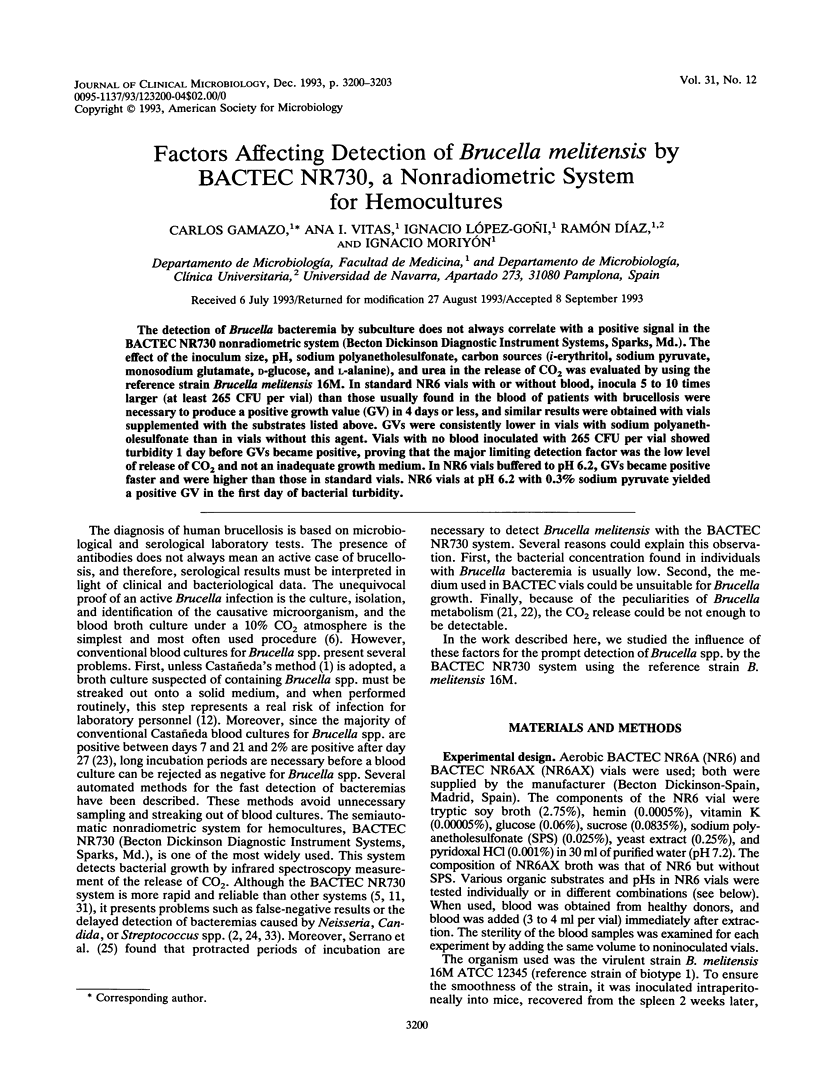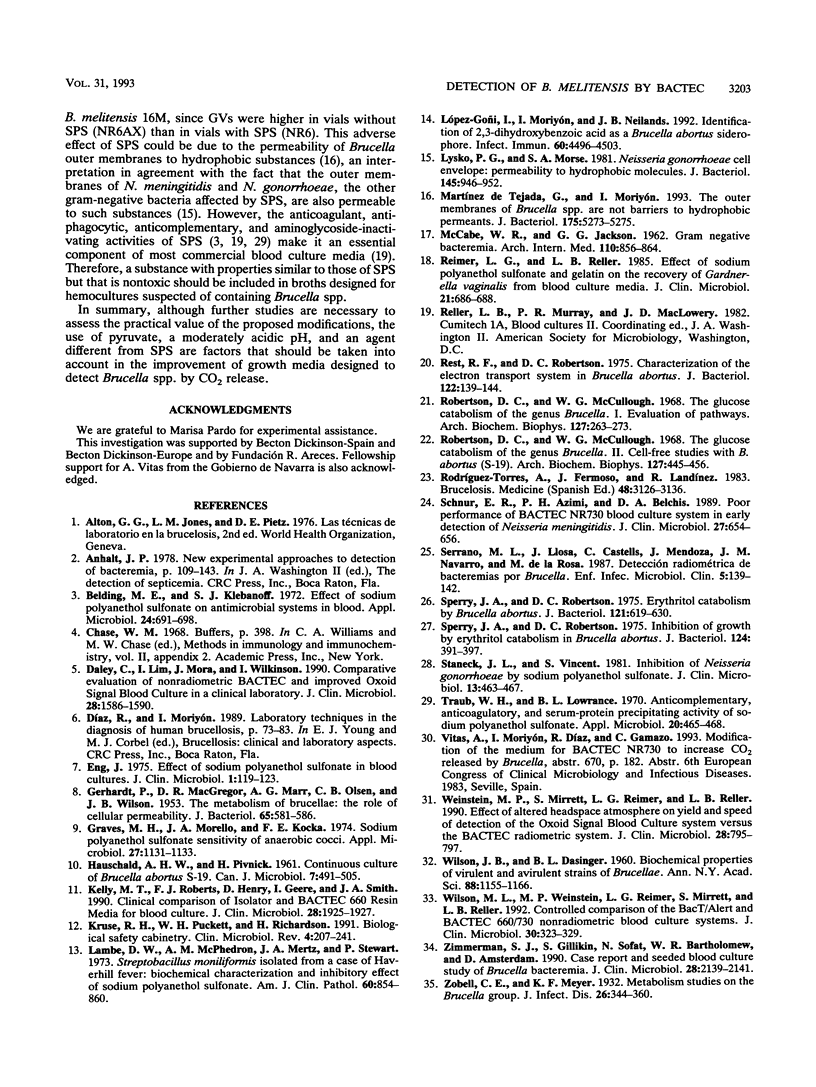Abstract
The detection of Brucella bacteremia by subculture does not always correlate with a positive signal in the BACTEC NR730 nonradiometric system (Becton Dickinson Diagnostic Instrument Systems, Sparks, Md.). The effect of the inoculum size, pH, sodium polyanetholesulfonate, carbon sources (i-erythritol, sodium pyruvate, monosodium glutamate, D-glucose, and L-alanine), and urea in the release of CO2 was evaluated by using the reference strain Brucella melitensis 16M. In standard NR6 vials with or without blood, inocula 5 to 10 times larger (at least 265 CFU per vial) than those usually found in the blood of patients with brucellosis were necessary to produce a positive growth value (GV) in 4 days or less, and similar results were obtained with vials supplemented with the substrates listed above. GVs were consistently lower in vials with sodium polyanetholesulfonate than in vials without this agent. Vials with no blood inoculated with 265 CFU per vial showed turbidity 1 day before GVs became positive, proving that the major limiting detection factor was the low level of release of CO2 and not an inadequate growth medium. In NR6 vials buffered to pH 6.2, GVs became positive faster and were higher than those in standard vials. NR6 vials at pH 6.2 with 0.3% sodium pyruvate yielded a positive GV in the first day of bacterial turbidity.
Full text
PDF



Selected References
These references are in PubMed. This may not be the complete list of references from this article.
- Belding M. E., Klebanoff S. J. Effect of sodium polyanetholesulfonate on antimicrobial systems in blood. Appl Microbiol. 1972 Nov;24(5):691–698. doi: 10.1128/am.24.5.691-698.1972. [DOI] [PMC free article] [PubMed] [Google Scholar]
- Daley C., Lim I., Modra J., Wilkinson I. Comparative evaluation of nonradiometric BACTEC and improved oxoid signal blood culture systems in a clinical laboratory. J Clin Microbiol. 1990 Jul;28(7):1586–1590. doi: 10.1128/jcm.28.7.1586-1590.1990. [DOI] [PMC free article] [PubMed] [Google Scholar]
- Eng J. Effect of sodium polyanethol sulfonate in blood cultures. J Clin Microbiol. 1975 Feb;1(2):119–123. doi: 10.1128/jcm.1.2.119-123.1975. [DOI] [PMC free article] [PubMed] [Google Scholar]
- GERHARDT P., MAC GREGOR D. R., MARR A. G., OLSEN C. B., WILSON J. B. The metabolism of brucellae: the role of cellular permeability. J Bacteriol. 1953 May;65(5):581–586. doi: 10.1128/jb.65.5.581-586.1953. [DOI] [PMC free article] [PubMed] [Google Scholar]
- Graves M. H., Morello J. A., Kocka F. E. Sodium polyanethol sulfonate sensitivity of anaerobic cocci. Appl Microbiol. 1974 Jun;27(6):1131–1133. doi: 10.1128/am.27.6.1131-1133.1974. [DOI] [PMC free article] [PubMed] [Google Scholar]
- HAUSCHILD A. H., PIVNICK H. Continuous culture of Brucella abortus S.19. Can J Microbiol. 1961 Aug;7:491–505. doi: 10.1139/m61-059. [DOI] [PubMed] [Google Scholar]
- Kelly M. T., Roberts F. J., Henry D., Geere I., Smith J. A. Clinical comparison of isolator and BACTEC 660 resin media for blood culture. J Clin Microbiol. 1990 Sep;28(9):1925–1927. doi: 10.1128/jcm.28.9.1925-1927.1990. [DOI] [PMC free article] [PubMed] [Google Scholar]
- Kruse R. H., Puckett W. H., Richardson J. H. Biological safety cabinetry. Clin Microbiol Rev. 1991 Apr;4(2):207–241. doi: 10.1128/cmr.4.2.207. [DOI] [PMC free article] [PubMed] [Google Scholar]
- Lambe D. W., Jr, McPhedran A. M., Mertz J. A., Stewart P. Streptobacillus moniliformis isolated from a case of Haverhill fever: biochemical characterization and inhibitory effect of sodium polyanethol sulfonate. Am J Clin Pathol. 1973 Dec;60(6):854–860. doi: 10.1093/ajcp/60.6.854. [DOI] [PubMed] [Google Scholar]
- Lysko P. G., Morse S. A. Neisseria gonorrhoeae cell envelope: permeability to hydrophobic molecules. J Bacteriol. 1981 Feb;145(2):946–952. doi: 10.1128/jb.145.2.946-952.1981. [DOI] [PMC free article] [PubMed] [Google Scholar]
- López-Goñi I., Moriyón I., Neilands J. B. Identification of 2,3-dihydroxybenzoic acid as a Brucella abortus siderophore. Infect Immun. 1992 Nov;60(11):4496–4503. doi: 10.1128/iai.60.11.4496-4503.1992. [DOI] [PMC free article] [PubMed] [Google Scholar]
- Martínez de Tejada G., Moriyón I. The outer membranes of Brucella spp. are not barriers to hydrophobic permeants. J Bacteriol. 1993 Aug;175(16):5273–5275. doi: 10.1128/jb.175.16.5273-5275.1993. [DOI] [PMC free article] [PubMed] [Google Scholar]
- Reimer L. G., Reller L. B. Effect of sodium polyanetholesulfonate and gelatin on the recovery of Gardnerella vaginalis from blood culture media. J Clin Microbiol. 1985 May;21(5):686–688. doi: 10.1128/jcm.21.5.686-688.1985. [DOI] [PMC free article] [PubMed] [Google Scholar]
- Rest R. F., Robertson D. C. Characterization of the electron transport system in Brucella abortus. J Bacteriol. 1975 Apr;122(1):139–144. doi: 10.1128/jb.122.1.139-144.1975. [DOI] [PMC free article] [PubMed] [Google Scholar]
- Robertson D. C., McCullough W. G. The glucose catabolism of the genus Brucella. I. Evaluation of pathways. Arch Biochem Biophys. 1968 Sep 20;127(1):263–273. doi: 10.1016/0003-9861(68)90225-7. [DOI] [PubMed] [Google Scholar]
- Robertson D. C., McCullough W. G. The glucose catabolism of the genus Brucella. II. Cell-free studies with B. abortus (S-19). Arch Biochem Biophys. 1968 Sep 20;127(1):445–456. doi: 10.1016/0003-9861(68)90249-x. [DOI] [PubMed] [Google Scholar]
- Schnur E. R., Azimi P. H., Belchis D. A. Poor performance of BACTEC NR 730 blood culture system in early detection of Neisseria meningitidis. J Clin Microbiol. 1989 Apr;27(4):654–656. doi: 10.1128/jcm.27.4.654-656.1989. [DOI] [PMC free article] [PubMed] [Google Scholar]
- Sperry J. F., Robertson D. C. Erythritol catabolism by Brucella abortus. J Bacteriol. 1975 Feb;121(2):619–630. doi: 10.1128/jb.121.2.619-630.1975. [DOI] [PMC free article] [PubMed] [Google Scholar]
- Sperry J. F., Robertson D. C. Inhibition of growth by erythritol catabolism in Brucella abortus. J Bacteriol. 1975 Oct;124(1):391–397. doi: 10.1128/jb.124.1.391-397.1975. [DOI] [PMC free article] [PubMed] [Google Scholar]
- Staneck J. L., Vincent S. Inhibition of Neisseria gonorrhoeae by sodium polyanetholesulfonate. J Clin Microbiol. 1981 Mar;13(3):463–467. doi: 10.1128/jcm.13.3.463-467.1981. [DOI] [PMC free article] [PubMed] [Google Scholar]
- Traub W. H., Lowrance B. L. Anticomplementary, anticoagulatory, and serum-protein precipitating activity of sodium polyanetholsulfonate. Appl Microbiol. 1970 Sep;20(3):465–468. doi: 10.1128/am.20.3.465-468.1970. [DOI] [PMC free article] [PubMed] [Google Scholar]
- WILSON J. B., DASINGER B. L. Biochemical properties of virulent and avirulent strains of brucellae. Ann N Y Acad Sci. 1960 Nov 21;88:1155–1166. doi: 10.1111/j.1749-6632.1960.tb20106.x. [DOI] [PubMed] [Google Scholar]
- Weinstein M. P., Mirrett S., Reimer L. G., Reller L. B. Effect of altered headspace atmosphere on yield and speed of detection of the Oxoid Signal blood culture system versus the BACTEC radiometric system. J Clin Microbiol. 1990 Apr;28(4):795–797. doi: 10.1128/jcm.28.4.795-797.1990. [DOI] [PMC free article] [PubMed] [Google Scholar]
- Wilson M. L., Weinstein M. P., Reimer L. G., Mirrett S., Reller L. B. Controlled comparison of the BacT/Alert and BACTEC 660/730 nonradiometric blood culture systems. J Clin Microbiol. 1992 Feb;30(2):323–329. doi: 10.1128/jcm.30.2.323-329.1992. [DOI] [PMC free article] [PubMed] [Google Scholar]
- Zimmerman S. J., Gillikin S., Sofat N., Bartholomew W. R., Amsterdam D. Case report and seeded blood culture study of Brucella bacteremia. J Clin Microbiol. 1990 Sep;28(9):2139–2141. doi: 10.1128/jcm.28.9.2139-2141.1990. [DOI] [PMC free article] [PubMed] [Google Scholar]


